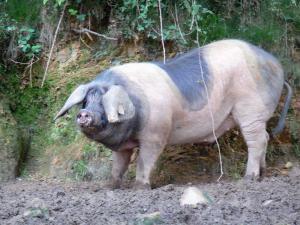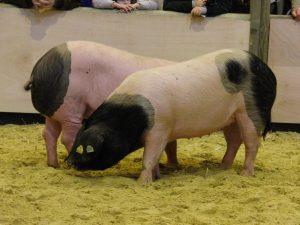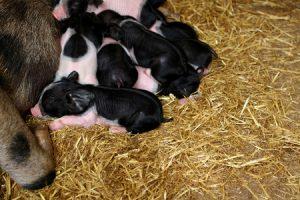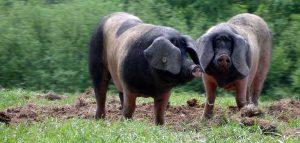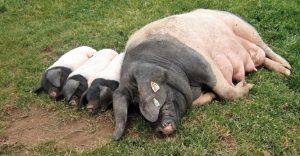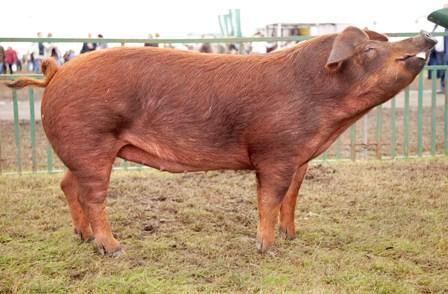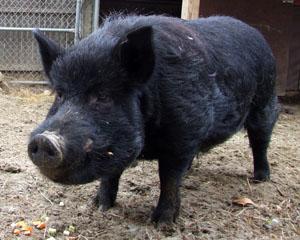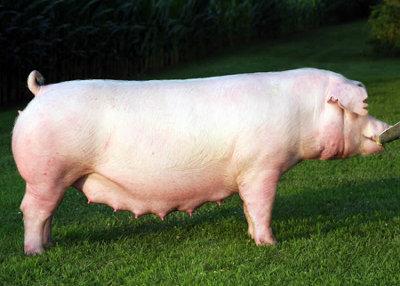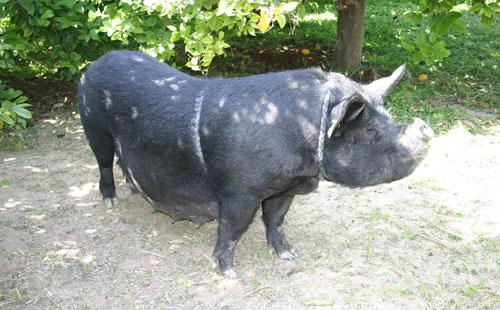Basque Pig
The Basque Pig is a very rare breed of domesticated swine that developed in the Basque Country region of France and Spain. They are mainly raised for the production of pork, which is popular for its excellent quality and aroma. These pigs were almost on the verge of extinction until efforts were taken for their revival.
| Also Known As | Euskal Txerri (Basque), Pie Noir du Pays Basque (French) |
| Characteristics | Medium to big stature; the head is strong with a solid snout; the limbs are strongly built (helping them to walk easily unlike in many other breeds), the coat is silky having large black spots; the rump and head is black, while the back part is convex; the ears are fat and big hanging over the eyes |
| Personality Traits | Good-natured, hardy, adaptable |
| Coat Hair | Short, smooth |
| Color | Black, pink, piebald |
| Uses | Meat production |
| Weight (Size) | 140–160 kg (adult boars and sows) |
| Litter Size | 9 (approx.) |
| Diet | Herbs, seasonal fruits like acorns, chestnuts, beechnuts, grass; Breeders also provide with food supplements of GM free cereals daily to ensure a balance in everyday diet |
| Country of Origin | Basque Country (France, Spain) |
History and Development
The Basque pig is the first pig to be mentioned in the herd book even before the popular Large White pigs, which entered in the book in 1928. Originally, the Basque pig comes from the Bearn and Hautes Pyrénées regions of Basque country that falls in South West France. This breed was much common in the early 20th century.
A breed of Iberic pig, the Basque is one of the six local breeds that have been acknowledged officially in the country (with the other five being the Bayeux, the Western White, the Gascon, the Limousin, and the Corse).
In 1981, with lesser than 100 breeding sows remaining, the Ministry of Agriculture of the country officially declared it as an endangered species. The breed went nearly extinct until quick initiatives were taken by a handful of local breeders to keep it from extinction.
The breed was consolidated under the name only in the 1920s. At present, the breed is maintained and preserved by small farmers in Spain and France who are devotedly committed in sustaining the tradition of well-known Basque foods like boudin, chicons, hure, cured jowl, as well as bacon.
Farming
The Basque pigs roam around freely in the mountainside and the forest areas during outdoor farming, and take shelter at night in the wooden cabins made with fern roofs. They are not well-suited to confinement.
The litter size of the Basque sows is about 9. They make good mothers, and have a strong maternal instinct.
These pigs primarily feast upon (from September to the first snow), etc. However, they are also fed with food supplements of GM free cereals daily in order to ensure a balance in their everyday food.
Meat Production
These pigs grow up relatively slower than most other pig breeds. However, they grow more fat than the modern pork breeds like the popular Large White. This makes the Basques less suitable for intensive commercial pork production, but they are ideal for the production of cured pork products like Bayonne ham.
The meat of the Basque is dark red, flavorful and tender. Because of the natural staple diet, the genetic characteristics of the breed, and traditional outdoor farming, the quality of the meat is excellent. The fresh grass included in their daily diet makes the adipose tissue store more antioxidants and fatty acids, making it excellent for curing.
In the first 2 months from birth, a piglet weighs about 20 kg, while the live weight of a mature adult is between 140 and 160 kg. In ham, though the surface of the fat and the cured lard is firm, but it is oily, and melts in the mouth. The lean meat is elastic, soft, and tender.
Interesting Facts
- In honor of the rich and sustaining territory of Kintoa, the Basque breeders use the same name (‘Kintoa’) for fresh meats and cured hams derived from these pigs.
- At present, the Basque pigs often take part in many agriculture-based shows.
- The average growth of the Basque pig is 300 grams per day.

